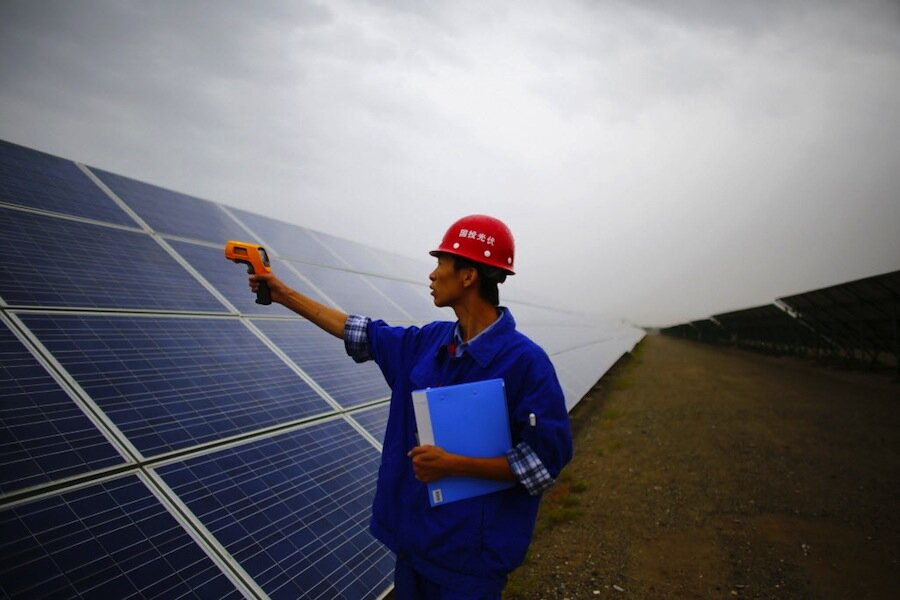China is crushing it on climate change, study says
Loading...
While economies across the globe struggle to even formulate climate goals, one country may be ahead of its own ambitious schedule.
China – the world’s No. 1 emitter of greenhouse gases – is on track to peak emissions five years ahead of its pledged goal, according to a new study from the London School of Economics. By 2025, China’s planet-warming emissions will reach an upper limit, the study says, and begin a steady descent that scientists say is critical to curbing the worst effects of climate change.
“They could peak even earlier than that,” Fergus Green and Nicholas Stern, the authors of the London School of Economics study, wrote in their report. “With a comprehensive approach to reform, [emissions] could also fall rapidly post-peak.”
The study is welcome news for climate negotiators working toward a deal that would cut greenhouse emissions. Negotiators, who will meet in December to finalize a global climate agreement, have a lofty goal: Keep warming to 2 degrees Celsius, or 3.6 degrees Fahrenheit.
Many observers wonder if such an ambitious goal is even possible given the emissions reductions pledges countries have put on the table so far. Those pledges will be the raw material for the carbon-cutting deal that world leaders aim to reach at climate talks in Paris this December. And news of China’s better-than-expected progress lends momentum to pre-talk deliberations.
“This finding suggests it is increasingly likely that the world will avoid global warming of more than 2C above pre-industrial levels,” Mr. Green and Mr. Stern said in a statement.
G7 leaders from nations like the US, Japan, and Germany reaffirmed their commitment to the 2-degree Celsius target Monday at a summit in the Bavarian Alps. But the G7 represents some of the wealthiest, most developed nations on the planet, and whether or not the world can rein in runaway emissions depends largely on China, India, and other developing nations. India has yet to promise emissions cuts, but China peaking emissions in 2025 “greatly increases the prospects for keeping global ... emissions within relatively safe limits,” the authors write.
Carbon-heavy coal power has fueled China’s explosive growth over the last several decades, and the climate and public health impacts of the fossil fuel are beginning to take their toll. The growing nation of 1.4 billion and has set aggressive targets for clean energy, and has shuttered coal plants to tackle smog pollution that threatens public health.
Still, China peaking its emissions as early as 2025 does not mean carbon pollution will immediately taper. Emissions could simply plateau, considering the 50-year life expectancy of the country’s coal-fired power plants.
New Chinese coal plants “will be around and cranking away for many decades, along with the rest of China’s coal fleet, most of which is less than 15 years old,” Armond Cohen, executive director of the Clean Air Task Force, a Boston-based nonprofit, wrote in a February blog post. “[T]hese plants can continue to pump CO2 out well into the second half of this century even with China’s pledged 2030 CO2 peak. And once in the atmosphere, those CO2 emissions will be warming the planet for many centuries to come.”
In the past, Republicans on Capitol Hill and nations reluctant to cut carbon have argued that slashing emissions is pointless so long as China – by far the leading emitter – continues to pump carbon dioxide into the atmosphere.
But last fall’s US-China climate accord complicated that argument: China agreed to peak emissions by 2030 and cut its carbon footprint from there, and the US agreed to cut emissions 26 to 28 percent by 2025. Now, it looks like China might do even better.
Beyond China and the US, there’s evidence that the world can reduce emissions while still maintaining healthy economic growth. As the Monitor reported in April, last year the world experienced economic growth without an accompanying rise in emissions levels. That’s a hopeful trend for countries offering up carbon-cutting pledges ahead of December talks in Paris.
“This should give them confidence that they can meet their emissions targets and still grow their economies,” Jennifer Morgan, global director of the climate program at the World Resources Institute, a Washington-based think tank, told the Monitor in April.







